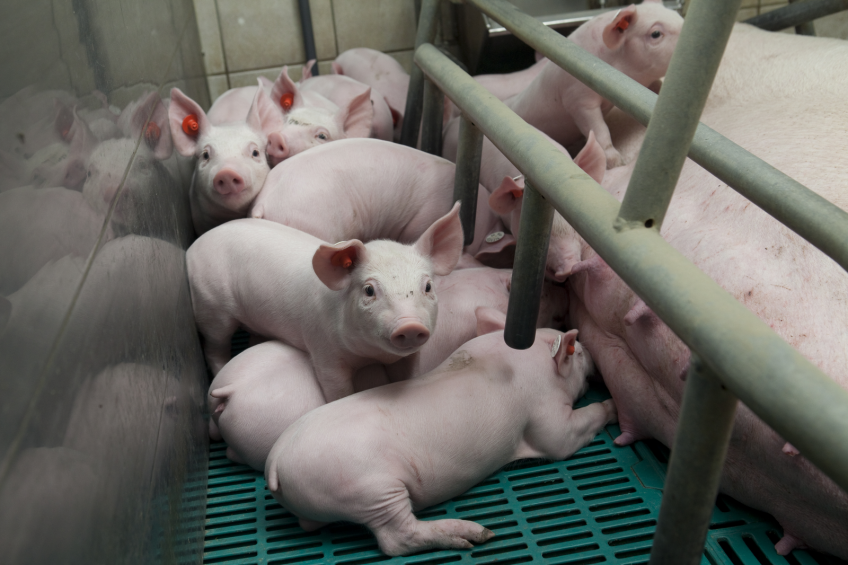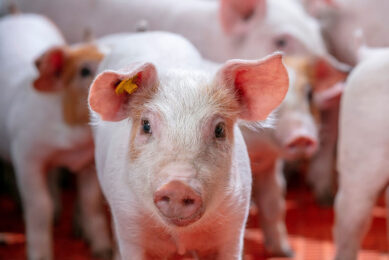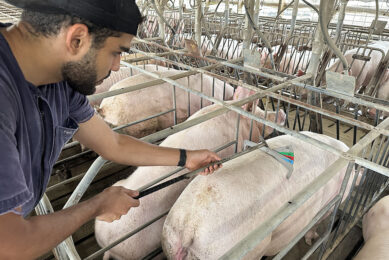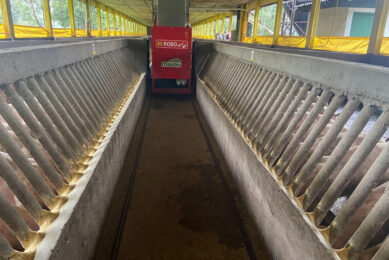Lactating-gestating sows need high feeding levels

Sows combining gestation and lactation are best fed on a high feeding level, with diets rich in starch. This results in a better condition recovery than feeding on a standard level.
Such were the outcomes of trials at the Swine Innovation Centre Sterksel, part of Wageningen UR, the Netherlands.
Combining gestation with lactation
The trials are part of a larger attempt to devise management strategies in which gestation and lactation are a more fluent process. In order to encourage sows to get in heat, the principle of intermittent suckling is applied. With this method, sows and piglets are separated for roughly 10 hours a day, resulting in sows coming in heat again after 5 days, after which insemination is possible.
The researchers wondered what the best feeding strategy would be for sows going through this process. Using lactating-gestating sows, they studied the effect of feeding a starch-rich or a fat-rich lactation diet during the last 8 days of a 6-week lactation. The scientists collected data on weight and backfat thickness, performance of the piglets and the number of liveborn and stillborn piglets in the next parity.
Feeding levels after weaning
In addition, they also studied the effect of feeding levels from weaning (about 9 days after insemination) until day 34 of gestation on weight and backfat thickness. Again, also the number of liveborn and stillborn piglets in the next parity was studied.
In a report, the researchers describe that the trials occurred in a 5-month period, in which 105 (7 batches of 15 sows) Y x NL sows of parity 2-7 were allotted to the experiment. One week before, farrowing sows were moved to farrowing pens. On day 27 of lactation intermittent suckling started, to induce lactational oestrus.
Intermittent suckling
It is described that during a period of 7 days, sows and piglets were separated for 10 hours per day. At the start of intermittent suckling on day 27, piglets were moved to lactation-rearing pens in which they were housed as a litter until weaning. Sows were moved to free access stalls in the mating stable at 6 am. At 4 pm, they were moved to their piglets in the suckling-rearing pens.
In the mating room oestrus was checked twice a day in the presence of a mature boar. Sows that showed oestrus were inseminated each day of standing oestrus. After insemination, intermittent suckling was no longer applied and sows remained with their piglets until weaning on day 42 after farrowing. Until day 34 of lactation, all sows were fed the same lactation diet. From day 34 until day 42 sows were fed either a starch-rich or a fat-rich diet lactation diet.
Standard feeding levels or high feeding levels
From weaning (about 9 days after insemination) until day 34 of gestation sows were fed 2.8 kg/d (standard feeding level) or 3.5 kg/d (high feeding level) of a commercial gestation diet.
When comparing the starch-rich vs. fat-rich lactation diet during the last 8 days of a 6-week lactation, the researchers found that weight loss (9 vs. 13 kg) during the last 8 days of the 6-week lactation tended to be lower in the sows that were fed the starch rich diet. In addition, the occurrence of diarrhoea during the last 8 days of the 6-week lactation was higher in piglets from sows that were fed the fat rich diet.
High vs. standard feeding level after weaning
When studying high vs. standard feeding levels from weaning until day 34 of gestation, the researchers found that the percentage of pregnant sows 4 weeks after insemination was higher in sows that were fed the high feeding level until day 34 of gestation.
In addition, body weight gain from weaning until the day of transfer to the farrowing room was higher in sows that were fed the high feeding level until day 34 of gestation (67.8 versus 59.0 kg).
Feed4Foodure
The research was part of the public-private partnership ‘Feed4Foodure‘, a cooperation between the Netherlands ministry of economic affairs and a consortium of various organisations within the animal feed industry and the animal production chain. The research programme aims to contribute to sustainable and healthy livestock farming in the Netherlands.
The research, called ‘Effect of feed composition in gestating lactating sows and feeding level during early gestation on reproduction and condition‘, was authored by C.M.C. van der Peet-Schwering, R. Verheijen, G.P. Binnendijk, attached to Wageningen UR, the Netherlands.











